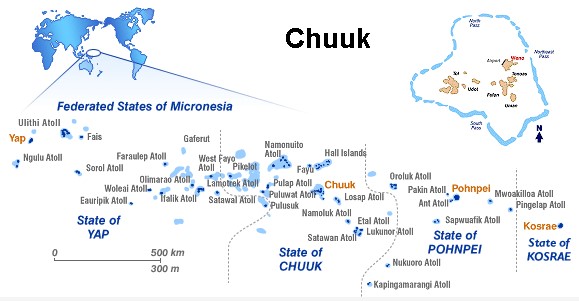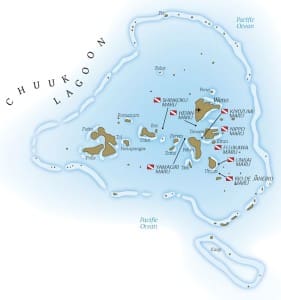Scuba Diving Chuuk (Truk)
Chuuk, with its vast, shallow, beautiful lagoon is a major shipwreck site from WWII.
The many islands within this huge atoll are crowned with natural beauty. The outer barrier reef is punctuated with idyllic sand spits dotted with coconut palms. The high islands in the central lagoon rise into the blue island skies.
In Chuuk, the pace of life slows and tropical nature is easily observed and appreciated. Many of the islands offer lush vegetation that harbors rare and migratory birdlife. Enthusiasts have been known to camp high in the hills to observe these special avians. Wild orchids and other flora are found in the scenic and sometimes rugged terrain of the islands. Lush vegetation and simple living punctuate the lives of the lagoon. Fishing, weaving and tending garden supplant the subsistence lives that many sustain on their individual islands. It is not unusual to see women waist deep in the mangroves hunting for a special delicacy or men walking the reefs by torchlight at night looking for octopus. Boat makers create vessels high in the hills of the inner islands and take them down to sea when finished. Open hearth fires are still used to cook the daily meals. Life here is close to nature and lived in conjunction with the land and the sea. Local carvers are also famous for using beautiful local woods to carve warrior masks and busts. And the Chuukese love stick is part of a legendary practice of courtship unique to this island group.
Chuuk, with its vast, shallow, beautiful lagoon is a major shipwreck site from WWII, Truk Lagoon is unquestionably the world’s best shipwreck diving destination. Here, more than 80 hulks (inside reef :40 hulks, out side reef :40 hulks) have been transformed into shipreefs, holding the very best of the undersea world and maritime history at one site. Hard and soft corals in a kaleidoscope of colors and shapes attract divers worldwide for both daytime and night diving. The vast selection of artifacts still found on the wrecks after six decades are testament to the unique history of the Micronesian Islands.
The historical aspect of Truk Lagoon is not totally hidden by the jungles. Japanese lighthouses, perched high atop the lagoon’s finest overlooks, can be reached by hiking or driving. Old runways, command centers, gun emplacements, cave networks, hospitals and libraries can be found with the help of a knowledgeable guide.
Traveling by ocean kayak from island to island is one way to enjoy Chuuk. Often overlooked are the outer reefs where a great variety of fish, both pelagic and reef dwelling, venture near cascading coral walls that stretch into the blue abyss of the Pacific Ocean. Windsurfing and sailing in the lagoon passes is also done during tradewind season.
A major WWII battle left the lagoon floor littered with WWII Japanese freight and armed military ships during Operation Hailstorm. Decades later, they have become natural reefs, adorned in coral with homes for fish but with all of the war artifacts still aboard. They are fascinating sites to visit and most are shallow enough for all experience levels of divers. The ships are now thickly overgrown reefs with over 700 fish species and nearly 400 corals plus numerous invertebrates.
HIGHLIGHT DIVE AREAS
Chuuk Atoll, (also Known as Truk) in the Caroline Islands is infamous for its giant lagoon. The lagoon is the final resting place for more than 100 ships, planes and submarines – the legacy of a fierce World War II battle between the Imperial Japanese Fleet and Allied carrier planes. The lagoon has been declared an underwater museum. Souvenir taking of relics from the area are prohibited by law.
Nowhere else in the world are there so many wrecks in close proximity, situated in shallow clear water. Many of the wrecks are visible while snorkelling and there are many on-shore wartime locations to visit.
The majority of the wrecks lie off DubIon, Eten, Fefan and Uman Islands and represent the largest naval loss in history. Their cargoes of tanks, trucks, airplanes, mines, bombs, machine gun bullets and thousands of other artefacts including beautiful china are there still to be explored.
CHUUK LAGOON Highlight Dive Sites
DIVE INFORMATION
Diving Season: Best time is dry season which is December – April, but it is possible to dive year round.
Visibility: In the lagoon is about 40-60 ft. If it is outside the lagoon, it can reach over 100ft.
Water Temperature: 82-84 degrees
Weather: Most days it is around 81°F (27°C) – sometimes it gets up to 90°F (32°C), sometimes it drops to 70°F (21°C). It is a little drier, cooler and breezier between December and April than it is the rest of the year. The wettest months are October and November and annual rainfall is about 140 inches. Typhoon season is between August and December but Chuuk rarely gets a direct hit from a typhoon.
Skill Levels: All skill levels of divers will have dives available to them. Several of the well known wrecks are deep dives which require advanced training and certification.
What To Expect to See: Coral encrusted ship wrecks from WWII plus sharks and massive schools of reef fish
GENERAL INFORMATION
CLIMATE: The Federated States of Micronesia has a tropical oceanic climate that is consistently warm and humid, with some of the most uniform year-round temperatures in the world. Between 70-90 degrees Fahrenheit (26-30 degrees Celsius); averaging 81 degrees Fahrenheit (28 degrees Celsius)
LANGUAGE: Chuukese is spoken in Truk Lagoon but English is also the official national language and most people speak it quite well. There are eight major indigenous languages of the Malayo-Polynesian linguistic family spoken in the FSM: Yapese, Ulithian, Woleaian, Chuukese, Pohnpeian, Kosraean, Nukuoro, and Kapingamarangi.
ELECTRICITY: 110V/120V, 60Hz
CURRENCY & CREDIT CARDS: US Dollar. Major resorts usually accept major credit cards. There are US banks here and some banking services. It is best to bring US dollars with you to Chuuk as money exchange can be a problem at times.
GRATUITIES: Tipping is up to each person and your personal experience at the location. No destinations in Micronesia require that you tip anyone. It’s customary to put your tip into an envelope and give to their supervisor prior to leaving the resort or cruise director on live aboard.
PHONE & INTERNET SERVICE: International telephone, telex and facsimile service is available through the larger hotels and the FSM Telecommunications Center.
VISA & PASSPORT REQUIREMENTS: A valid passport and a return or onward ticket.
CUSTOMS: Up to two liters of alcohol for visitors over 21 and reasonable perfume amounts for personal use. Tobacco restrictions are either 600 cigarettes or up to 454 grams of cigars or loose tobacco
DEPARTURE TAX: $20 US cash collected at airport prior to departure.
ETIQUETTE: The elderly are respected and held in high regard in Truk. Dresses for women are expected to cover the thigh. Swimwear for men and women should only be worn at the hotel beaches and on the dive boats.
Say It In Chuukese
Ran Annim – Hello, Good Day
Kinisou Chapur – Thank you
Nesor Annim – Good Morning
Nonowas Annim – Good Afternoon
Nepong Annim – Good Evening
Ifa Usum? – How are you?
Amusano – Excuse me.
Nioch – Beautiful
Itei – My name is …..
Ia – Where is ….. ?
USEFUL INFORMATION


